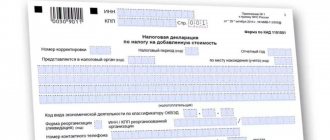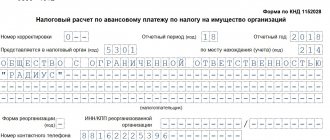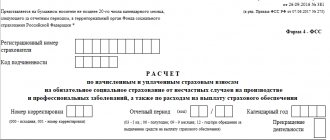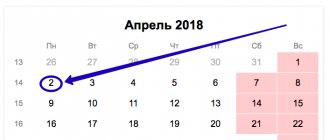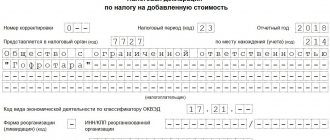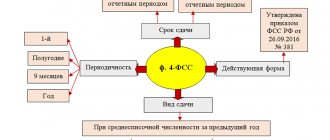Employer reporting
Denis Pokshan
Expert in taxes, accounting and personnel records
Current as of June 5, 2018
Organizations and individual entrepreneurs who own real estate, including office and retail premises that are not classified as beneficiaries according to regional legislation, are required to pay property tax for the 2nd quarter of 2021. To confirm the correctness of determining the amount transferred to the budget, business entities fill out declaration, which is sent within the established time frame to the fiscal authority.
Quarterly “property” reporting
For quarterly property tax reporting, an advance payment calculation form is provided, approved by order of the Federal Tax Service of Russia dated March 31, 2017 No. ММВ-7-21/
The calculation consists of:
- Title page;
- Section 1 “Amount of tax payable to the budget”;
- Section 2 “Determination of the tax base and calculation of the amount of tax in relation to the taxable property of Russian organizations and foreign organizations operating in the Russian Federation through permanent representative offices”;
- Section 2.1 “Information on real estate objects taxed at the average annual cost”;
- Section 3 “Calculation of the amount of tax for the tax period on a real estate object, the tax base in respect of which is determined as the cadastral value.”
But it (the calculation) is not useful to all organizations.
The fact is that intra-annual “property” calculations are mandatory only if the regional authorities have provided for such a system in their legal regulations. The absence of mention of reporting periods in the regional law relieves the organization of the need to submit calculations. Therefore, even before you start completing the calculation, take a look at the regional law on property tax.
This should also be done by those companies that are aware of the quarterly “property” obligation, but have not updated the nuances of regional legislation for a long time. It is likely that new information has appeared there that could affect the amount of the quarterly “property” advance. After all, after the abolition of the federal benefit on movable property, the regions were given the right to establish benefits on movable property. They must provide for all the nuances in regional “property” legislation.
From 01/01/2018, movable property of III and subsequent depreciation groups (i.e. with a useful life of more than 3 years), which was registered on 01/01/2013, is exempted only if the corresponding benefit is established by a constituent entity of the Russian Federation (clause 1 Article 381.1 of the Tax Code of the Russian Federation).
If such a benefit is not established, property tax on this movable property will have to be paid. At what rate - the regional law will indicate, but in any case - no higher than 1.1% in 2018 (clause 3.3 of Article 380 of the Tax Code of the Russian Federation, as amended, valid from 01/01/2018).
IMPORTANT! Don’t get confused - you need to submit not a quarterly property tax return, but an advance calculation. The deadline for its submission is no later than 30 days from the end of the quarter (clause 2 of Article 386 of the Tax Code of the Russian Federation).
Calculations of advance payments for property tax in 2021 are due within the following deadlines:
- for the 1st quarter of 2021 – 05/03/2018 (including transfer);
- half year 2021 – 07/30/2018;
- 9 months 2021 – 10/30/2018.
The 2021 property tax return is due no later than April 1, 2021.
How to fill out a property tax return
You can download the official instructions for filling out the declaration from this link.
Basic rules for filling out the declaration
- Data is entered into the declaration from left to right, starting from the first cell; if there are unfilled cells, a dash must be placed in them;
- If there is no data in any field (line), a dash is also placed in the cells;
- When filling out using a computer, numbers are aligned to the right;
- Cost indicators are indicated in full rubles according to the rounding rules (values less than 50 kopecks are discarded, more than 50 kopecks are rounded to the nearest ruble);
- At the top of the declaration, the TIN and KPP of the organization are indicated;
- Each page must contain a serial number specified in the format 001, 010, etc.;
- The property tax declaration consists of a Title Page, Sections 1, 2, 3. All sheets are required to be completed, even if some sections lack information (for example, there is no property with a cadastral value);
- When filling, it is allowed to use black, blue or purple ink;
- When filling out, you cannot use corrective or other means to correct errors;
- Stapling or stapling sheets, as well as double-sided document printing is not allowed;
- When filling out information manually, it is necessary to write it in capital block letters;
- When filling out using a computer, it is recommended to use Courier New font 16 – 18;
- When submitting a declaration for 2021, the code of the main type of activity must be indicated in accordance with the new edition of OKVED. You can find out the code using our OKVED code compliance service.
Place and deadline for payment: we follow the rules
An example will help you understand these questions:
At the end of the 1st quarter of 2021, Tango LLC, Reserve LLC and Concern TTM PJSC submitted quarterly settlements for “property” advance payments:
- LLC "Tango" - sent four paper calculations on April 17, 2018 (for the parent company and three branches);
- LLC "Reserve" - reported on May 15, 2018 for the “property” advance in one payment in electronic form;
- PJSC Concern prepared 9 calculations and submitted them on April 19, 2018 to the INFS at the place of registration of the head office and each of the separate divisions allocated with property.
Information about the companies is given in the table:
| Name | Average headcount for 2021, people. | Number of separate divisions with property that have a separate balance sheet | additional information | |
| Within the region where the parent company is registered | Outside the region | |||
| Tango LLC | 0 | 2 | 1 | Start of operations ─ March 2021 (number of employees - 101 people) |
| LLC "Reserve" | 12 | — | — | Microenterprise |
| PJSC "Concern TTM" | 1 399 | 5 | 3 | Largest taxpayer from 2021 |
All companies made mistakes when submitting tax calculations for property taxes:
- Tango LLC reported on paper, although the average headcount exceeded 100 people. (clause 3 of article 80 of the Tax Code of the Russian Federation). For a newly formed company, this indicator is taken at the time of commencement of activity.
- For Reserve LLC, a paper calculation could not become a reason for a fine - with a staff of no more than 100 people. he has access to both methods of submitting a report (both electronic and paper). But the calculation was submitted late (later than the date established in paragraph 2 of Article 386 of the Tax Code of the Russian Federation - 30 calendar days after the reporting quarter).
- PJSC Concern TTM, instead of 9 settlements to different Federal Tax Service Inspectors, is obliged to submit one settlement to the inspection for the largest taxpayers (clause 1 of Article 386 of the Tax Code of the Russian Federation).
In addition, Tango LLC had the opportunity to simplify reporting procedures by reducing the number of submitted calculations for separate divisions located in the same region (letter of the Federal Tax Service dated September 13, 2017 No. BS-4-21/). The need to submit several calculations is eliminated for such companies if, before the start of the tax period, the possibility of submitting one “property” calculation is agreed upon with the tax authorities and the recipient of its receipt is determined.
As you can see, when submitting property tax calculations in 2018, you need to observe a number of important nuances: deadlines, place and format of submission.
Read also
27.10.2017
Methods for submitting a property tax return
Organizations must submit a declaration:
- To the Federal Tax Service at the place of your registration.
- To the Federal Tax Service at the location of each separate division.
- To the Federal Tax Service at the location of the real estate, if it is located separately from the parent organization and separate divisions.
Note
: if an organization is the largest taxpayer, it must report at its place of registration.
A property tax return can be sent to the tax authority in three ways:
- In paper form (in 2 copies) in person or through your representative. When submitted, one copy of the report remains with the Federal Tax Service, and the second is marked with acceptance and returned. A stamp indicating the date of receipt of the declaration in the event of controversial situations will serve as confirmation of the timely submission of the document;
- By mail in a valuable letter with a list of the contents. Confirmation of sending the declaration in this case will be a list of the attachment (indicating the sent declaration) and a receipt with the date of sending;
- In electronic form via TKS (through electronic document management operators).
Note
: to submit a declaration through a representative, it is necessary to draw up a power of attorney for him, certified by the seal of the organization and the signature of the manager.
note
, when submitting reports on paper, some Federal Tax Service Inspectors may require:
- Attach the declaration file in electronic form on a floppy disk or flash drive;
- Print a special barcode on the declaration that duplicates the information contained in the reporting.
These requirements are not provided for by the Tax Code of the Russian Federation, but are encountered in practice and may lead to refusal to accept the declaration. If this happens, the fact of refusal to accept can be challenged with a higher tax authority (especially if the refusal resulted in missing the deadline for submitting the document and additional penalties being assessed).
The absence of a two-dimensional barcode, as well as incorrect indication of the OKTMO code (if there are no other comments and the declaration complies with the established form) cannot be reasons for refusal to accept the declaration (this is directly stated in the Letter of the Ministry of Finance of the Russian Federation dated April 18, 2014 No. PA- 4-6/7440.
What reports and when to submit to the Pension Fund?
The following table shows the deadlines for submitting reports to the Pension Fund in 2018.
| Report type | Period | Deadline |
| Information about insured persons in the Pension Fund (SZV-M) | For December 2021 | No later than 01/15/2018 |
| For January 2018 | No later than 02/15/2018 | |
| For February 2018 | No later than March 15, 2018 | |
| For March 2018 | No later than 04/16/2018 | |
| For April 2018 | No later than 05/15/2018 | |
| For May 2018 | No later than June 15, 2018 | |
| For June 2018 | No later than July 16, 2018 | |
| For July 2018 | No later than 08/15/2018 | |
| For August 2018 | No later than September 17, 2018 | |
| For September 2018 | No later than 10/15/2018 | |
| For October 2018 | No later than 11/15/2018 | |
| For November 2018 | No later than 12/17/2018 | |
| Information about the insurance experience of the insured persons (SZV-STAZH) | For 2021 | No later than 03/01/2018 |
| Information on the policyholder transferred to the Pension Fund for maintaining individual (personalized) records (EFV-1) | For 2021 | No later than 03/01/2018 |
New experience report: submitted for the first time
From January 1, 2021, it is necessary to take into account some changes in the composition and deadlines for submitting reports. For example, before March 1, 2018, employers must submit to the Pension Fund for the first time a new annual report on the length of service of employees using the SZV-STAZH form.
In order not to be mistaken about when and what report to submit, we offer our readers an accountant’s calendar for 2021 with deadlines for submitting main reports. If you miss the deadline, regulatory authorities may impose a fine. And for failure to submit individual reports, even block the current account.
Below we provide tables with deadlines for submitting main reports in 2018 (calendar).
Responsibility measures
The legislator provides for punishment only for late submission of a declaration for the reporting period (calendar year). According to Article 119 of the Tax Code of the Russian Federation, one cannot be held accountable for being late in submitting tax calculations for a quarter, half a year or 9 months. But for late filing of a declaration there are two types of liability:
- Tax office. The fine is 200 rubles (Article 126 of the Tax Code of the Russian Federation).
- Administrative. A fine for an official or founder in the amount of 300 to 500 rubles in accordance with Article 15.6 of the Code of Administrative Offenses of the Russian Federation.
It is worth noting that you can only be fined for non-payment or incomplete payment of property taxes. Advance payments, regardless of their size, are not subject to such sanctions. The fine is calculated in accordance with the amount that the taxpayer was required to transfer by the end of March (the deadline for filing the declaration) - it is indicated in column 030 and must be equal to the difference in the indicators in columns 220 and 230 of the second section.
If the condition is not met, the territorially authorized branch of the Federal Tax Service will request more accurate data on all points and make a decision based on the official response of the organization’s representative.
Failure to pay taxes may result in both administrative and criminal liability. The fine for violation is 20% of the amount specified in the declaration. If circumstances indicate deliberate evasion, the rate increases to 40%.
Exceptions and benefits
There are a number of exceptions to the rules. Clause 4 art. 374 of the Tax Code of the Russian Federation regulates the list of objects that are not taxed. The legislator includes:
- fixed assets of law enforcement agencies and law enforcement agencies;
- land;
- water bodies;
- Natural resources;
- cultural heritage sites;
- radioactive waste storage facilities;
- experimental power plants;
- icebreakers and nuclear-powered ships;
- objects related to the aerospace industry;
- vessels included in the Russian International Register of Ships;
- fixed assets belonging to the first two depreciation groups (with a useful life from one to three years).
The Tax Code of the Russian Federation provides for a number of tax benefits in Article 381 of the Tax Code of the Russian Federation. In addition to the conditions created for the development of sectors of the economy and social spheres, this part of the law makes it possible to reduce contributions to almost any organization whose balance sheet contains movable property, unless it became the property of the company as a result of the liquidation of another legal entity or a transaction between persons conducting joint activities. It is also impossible to do this if a standard reorganization of the company has occurred (for example, from a closed joint stock company to an LLC).
Also included in the preferential category is property acquired through an intermediary who is not an interdependent person in relation to the organization.
Accounting statements 2021
Annual financial statements must be submitted to the tax office no later than three months after the end of the reporting year (subclause 5, clause 1, article 23 of the Tax Code of the Russian Federation). At the same time, a mandatory copy of the annual reporting must be submitted to the statistics department (Part 2 of Article 18 of the Law of December 6, 2011 No. 402-FZ). That is, as a general rule, annual financial statements must be submitted no later than March 31 of the year following the reporting year.
March 31, 2021 is Saturday. Therefore, organizations (regardless of the applied taxation regime) must submit financial statements for 2017 to the Federal Tax Service and statistical authorities on the next working day. That is, no later than 04/02/2018.
Filling procedure
Step-by-step instructions for filling out a tax return.
Step No. 1. Title page
Here, provide all required information from the reporting organization. At the top of the sheet, enter your tax identification number and checkpoint, then sequentially indicate:
- Correction number. If the report is sent for the first time, then enter “0—”, for subsequent corrections indicate “1—” and so on chronologically.
- Enter the tax period “34”, then enter the reporting year.
- Enter information about the tax authority to which the declaration is submitted (code).
- Indicate the company code at its location:
In most cases, the code “214” is entered.
- Now write down the full name of the legal entity, contact phone number and information about the head of the enterprise or the authorized person responsible for submitting reports.
The lower right part of the title page remains blank. This part of the page is filled out by the Federal Tax Service inspector when accepting a tax return.
Step No. 2. Go to section 3
If the company owns property, the value of which is calculated based on the cadastral value, then it is necessary to fill out section 3 of the declaration.
The cadastral value is determined as of January 1 of the reporting period (year). If during the calendar year the value according to the cadastre has changed, then these changes should not be taken into account in calculating the tax.
If the cadastral value of a part (share) of an object is not determined, then it should be calculated in direct proportion, based on the area of the share and the total area of the object.
Step #3: Sections 2
IMPORTANT!
One report may contain several sections 2, this may be due to the following factors:
- objects have different OKTMO codes;
- property is taxed at different rates;
- Several benefits apply to the base;
- objects have different property codes.
Indicate the average annual value of taxable objects based on the residual value of the objects on the 1st day of each month of the reporting period (lines 010–140, column 3). Calculate the final calculation of the average annual cost using the arithmetic average for these fields.
Step #4: Section 2.1
This section provides information about taxable assets, the tax on which is calculated based on their average annual value.
Please indicate here:
- cadastral number of the property, if available;
- conditional number in accordance with the Unified State Register of Real Estate;
- inventory number, if a cadastral or conditional number is not assigned to the property object;
- OKOF code, in accordance with all-Russian classifiers;
- residual value of the property as of December 31.
Please note that if the property was disposed of before the end of the reporting period, then information about it should not be included in section 2.1.
Step #5: Section 1
On this sheet, indicate the amount of tax to be paid to the budget.
If advance payments are established in the region, then this section should take into account the already paid tranches.
If the amount of advance payments exceeded the total amount of the tax liability, then a dash is placed in line 030. And the overpaid difference is reflected in line 040.

